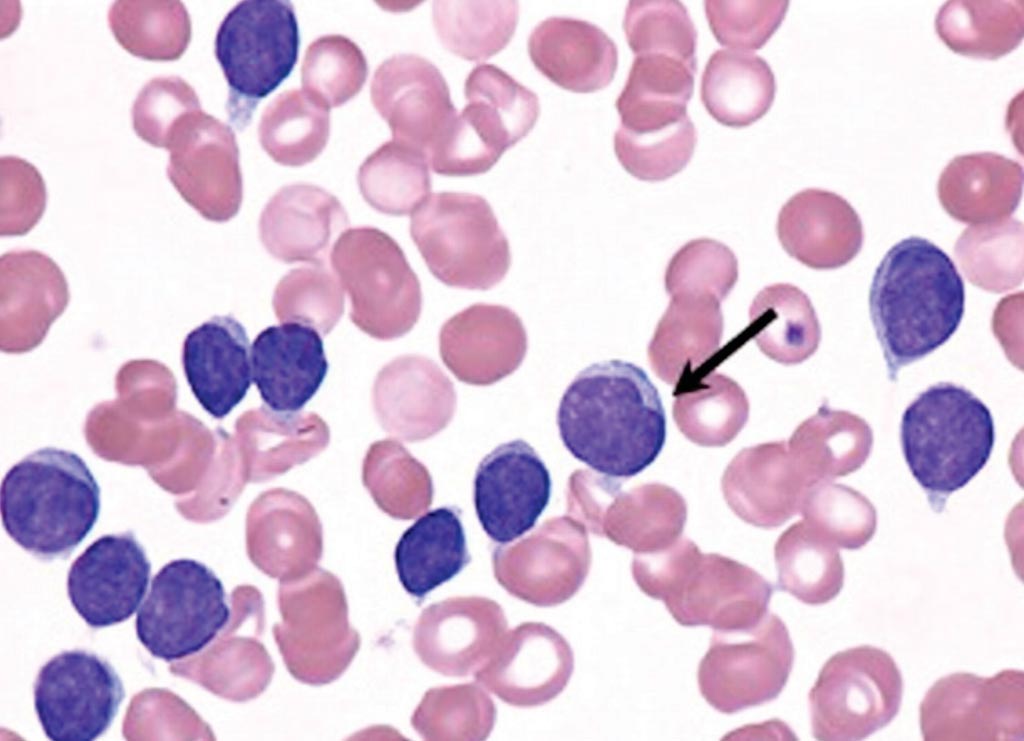New mRNA Cancer Drivers Revealed in Chronic Lymphocytic Leukemia
|
By LabMedica International staff writers Posted on 11 Sep 2018 |

Image: A blood film from a patient with Chronic Lymphocytic Leukemia (CLL); a large lymphocyte (arrow) has a notched nucleus and demonstrates the variable appearance of some of the lymphocytes in CLL (Photo courtesy of Peter Maslak).
New evidence has emerged showing that the inactivation or alteration of cancer suppressor genes can take place even if DNA itself remains unaltered. A known molecular mechanism for cancer development and spread is the inactivation of tumor suppressor genes, which encode various tools the body uses to keep its cells from turning cancerous.
Changes in messenger RNA (mRNA) due to a process called intronic polyadenylation (IPA) can drive development of some cancers by altering gene expression in a way that interferes with the proper functioning of tumor suppression mechanisms. Evidence is building that the hobbling of tumor suppressors can take place not just due to changes in the DNA itself, but by alterations in mRNAs, which act as a go-between, translating the DNA code into its intended function in the body.
Scientists at Memorial Sloan Kettering Cancer Center (New York, NY, USA) used an RNA sequencing method they developed to examine normal and malignant B cells from 59 chronic lymphocytic leukemia (CLL) patients. They found that the patients showed widespread tumor suppressor inactivation in mRNA even without a corresponding DNA alteration. The team reported that IPA truncated mRNAs in the CLL cohort predominantly affected genes with tumor-suppressive functions. In some cases (genes such as DICER and FOXN3) this appeared to result in the translation of truncated proteins, which lack the tumor-suppressive effect that they would have in their full-length form. In several other cases (CARD11, MGA and CHST11) the altered proteins even acted in an oncogenic manner.
Overall, the team concluded that the inactivation of tumor-suppressor genes by aberrant mRNA processing appears to be significantly more prevalent in CLL, at least based on this cohort, than functional loss of these genes via DNA mutations. The authors also reported that they saw truncated tumor-suppressor proteins not just for known tumor-suppressor genes but also in previously unrecognized or relatively understudied sequences. The study was published on August 27, 2018, in the journal Nature.
Related Links:
Memorial Sloan Kettering Cancer Center
Changes in messenger RNA (mRNA) due to a process called intronic polyadenylation (IPA) can drive development of some cancers by altering gene expression in a way that interferes with the proper functioning of tumor suppression mechanisms. Evidence is building that the hobbling of tumor suppressors can take place not just due to changes in the DNA itself, but by alterations in mRNAs, which act as a go-between, translating the DNA code into its intended function in the body.
Scientists at Memorial Sloan Kettering Cancer Center (New York, NY, USA) used an RNA sequencing method they developed to examine normal and malignant B cells from 59 chronic lymphocytic leukemia (CLL) patients. They found that the patients showed widespread tumor suppressor inactivation in mRNA even without a corresponding DNA alteration. The team reported that IPA truncated mRNAs in the CLL cohort predominantly affected genes with tumor-suppressive functions. In some cases (genes such as DICER and FOXN3) this appeared to result in the translation of truncated proteins, which lack the tumor-suppressive effect that they would have in their full-length form. In several other cases (CARD11, MGA and CHST11) the altered proteins even acted in an oncogenic manner.
Overall, the team concluded that the inactivation of tumor-suppressor genes by aberrant mRNA processing appears to be significantly more prevalent in CLL, at least based on this cohort, than functional loss of these genes via DNA mutations. The authors also reported that they saw truncated tumor-suppressor proteins not just for known tumor-suppressor genes but also in previously unrecognized or relatively understudied sequences. The study was published on August 27, 2018, in the journal Nature.
Related Links:
Memorial Sloan Kettering Cancer Center
Latest Molecular Diagnostics News
- Game-Changing Blood Test for Stroke Detection Could Bring Life-Saving Care to Patients
- Blood Proteins Could Warn of Cancer Seven Years before Diagnosis
- New DNA Origami Technique to Advance Disease Diagnosis
- Ultrasound-Aided Blood Testing Detects Cancer Biomarkers from Cells
- New Respiratory Syndromic Testing Panel Provides Fast and Accurate Results
- New Synthetic Biomarker Technology Differentiates Between Prior Zika and Dengue Infections
- Novel Biomarkers to Improve Diagnosis of Renal Cell Carcinoma Subtypes
- RNA-Powered Molecular Test to Help Combat Early-Age Onset Colorectal Cancer
- Advanced Blood Test to Spot Alzheimer's Before Progression to Dementia
- Multi-Omic Noninvasive Urine-Based DNA Test to Improve Bladder Cancer Detection
- First of Its Kind NGS Assay for Precise Detection of BCR::ABL1 Fusion Gene to Enable Personalized Leukemia Treatment
- Urine Test to Revolutionize Lyme Disease Testing
- Simple Blood Test Could Enable First Quantitative Assessments for Future Cerebrovascular Disease
- New Genetic Testing Procedure Combined With Ultrasound Detects High Cardiovascular Risk
- Blood Samples Enhance B-Cell Lymphoma Diagnostics and Prognosis
- Blood Test Predicts Knee Osteoarthritis Eight Years Before Signs Appears On X-Rays
Channels
Clinical Chemistry
view channel
3D Printed Point-Of-Care Mass Spectrometer Outperforms State-Of-The-Art Models
Mass spectrometry is a precise technique for identifying the chemical components of a sample and has significant potential for monitoring chronic illness health states, such as measuring hormone levels... Read more.jpg)
POC Biomedical Test Spins Water Droplet Using Sound Waves for Cancer Detection
Exosomes, tiny cellular bioparticles carrying a specific set of proteins, lipids, and genetic materials, play a crucial role in cell communication and hold promise for non-invasive diagnostics.... Read more
Highly Reliable Cell-Based Assay Enables Accurate Diagnosis of Endocrine Diseases
The conventional methods for measuring free cortisol, the body's stress hormone, from blood or saliva are quite demanding and require sample processing. The most common method, therefore, involves collecting... Read moreMolecular Diagnostics
view channel
Game-Changing Blood Test for Stroke Detection Could Bring Life-Saving Care to Patients
Stroke is the primary cause of disability globally and ranks as the second leading cause of death. However, timely early intervention can prevent severe outcomes. Most strokes are ischemic, resulting from... Read moreBlood Proteins Could Warn of Cancer Seven Years before Diagnosis
Two studies have identified proteins in the blood that could potentially alert individuals to the presence of cancer more than seven years before the disease is clinically diagnosed. Researchers found... Read moreImmunology
view channel.jpg)
AI Predicts Tumor-Killing Cells with High Accuracy
Cellular immunotherapy involves extracting immune cells from a patient's tumor, potentially enhancing their cancer-fighting capabilities through engineering, and then expanding and reintroducing them into the body.... Read more
Diagnostic Blood Test for Cellular Rejection after Organ Transplant Could Replace Surgical Biopsies
Transplanted organs constantly face the risk of being rejected by the recipient's immune system which differentiates self from non-self using T cells and B cells. T cells are commonly associated with acute... Read more
AI Tool Precisely Matches Cancer Drugs to Patients Using Information from Each Tumor Cell
Current strategies for matching cancer patients with specific treatments often depend on bulk sequencing of tumor DNA and RNA, which provides an average profile from all cells within a tumor sample.... Read more
Genetic Testing Combined With Personalized Drug Screening On Tumor Samples to Revolutionize Cancer Treatment
Cancer treatment typically adheres to a standard of care—established, statistically validated regimens that are effective for the majority of patients. However, the disease’s inherent variability means... Read moreMicrobiology
view channel
Integrated Solution Ushers New Era of Automated Tuberculosis Testing
Tuberculosis (TB) is responsible for 1.3 million deaths every year, positioning it as one of the top killers globally due to a single infectious agent. In 2022, around 10.6 million people were diagnosed... Read more
Automated Sepsis Test System Enables Rapid Diagnosis for Patients with Severe Bloodstream Infections
Sepsis affects up to 50 million people globally each year, with bacteraemia, formerly known as blood poisoning, being a major cause. In the United States alone, approximately two million individuals are... Read moreEnhanced Rapid Syndromic Molecular Diagnostic Solution Detects Broad Range of Infectious Diseases
GenMark Diagnostics (Carlsbad, CA, USA), a member of the Roche Group (Basel, Switzerland), has rebranded its ePlex® system as the cobas eplex system. This rebranding under the globally renowned cobas name... Read more
Clinical Decision Support Software a Game-Changer in Antimicrobial Resistance Battle
Antimicrobial resistance (AMR) is a serious global public health concern that claims millions of lives every year. It primarily results from the inappropriate and excessive use of antibiotics, which reduces... Read morePathology
view channel
New AI Tool Classifies Brain Tumors More Quickly and Accurately
Precision in diagnosing and categorizing tumors is essential for delivering effective treatment to patients. Currently, the gold standard for identifying various types of brain tumors involves DNA methylation-based... Read more
AI Integrated With Optical Imaging Technology Enables Rapid Intraoperative Diagnosis
Rapid and accurate intraoperative diagnosis is essential for tumor surgery as it guides surgical decisions with precision. Traditional intraoperative assessments, such as frozen sections based on H&E... Read more
HPV Self-Collection Solution Improves Access to Cervical Cancer Testing
Annually, over 604,000 women across the world are diagnosed with cervical cancer, and about 342,000 die from this disease, which is preventable and primarily caused by the Human Papillomavirus (HPV).... Read moreHyperspectral Dark-Field Microscopy Enables Rapid and Accurate Identification of Cancerous Tissues
Breast cancer remains a major cause of cancer-related mortality among women. Breast-conserving surgery (BCS), also known as lumpectomy, is the removal of the cancerous lump and a small margin of surrounding tissue.... Read moreTechnology
view channel
New Diagnostic System Achieves PCR Testing Accuracy
While PCR tests are the gold standard of accuracy for virology testing, they come with limitations such as complexity, the need for skilled lab operators, and longer result times. They also require complex... Read more
DNA Biosensor Enables Early Diagnosis of Cervical Cancer
Molybdenum disulfide (MoS2), recognized for its potential to form two-dimensional nanosheets like graphene, is a material that's increasingly catching the eye of the scientific community.... Read more
Self-Heating Microfluidic Devices Can Detect Diseases in Tiny Blood or Fluid Samples
Microfluidics, which are miniature devices that control the flow of liquids and facilitate chemical reactions, play a key role in disease detection from small samples of blood or other fluids.... Read more
Breakthrough in Diagnostic Technology Could Make On-The-Spot Testing Widely Accessible
Home testing gained significant importance during the COVID-19 pandemic, yet the availability of rapid tests is limited, and most of them can only drive one liquid across the strip, leading to continued... Read moreIndustry
view channel
Danaher and Johns Hopkins University Collaborate to Improve Neurological Diagnosis
Unlike severe traumatic brain injury (TBI), mild TBI often does not show clear correlations with abnormalities detected through head computed tomography (CT) scans. Consequently, there is a pressing need... Read more
Beckman Coulter and MeMed Expand Host Immune Response Diagnostics Partnership
Beckman Coulter Diagnostics (Brea, CA, USA) and MeMed BV (Haifa, Israel) have expanded their host immune response diagnostics partnership. Beckman Coulter is now an authorized distributor of the MeMed... Read more_1.jpg)












_1.jpg)
